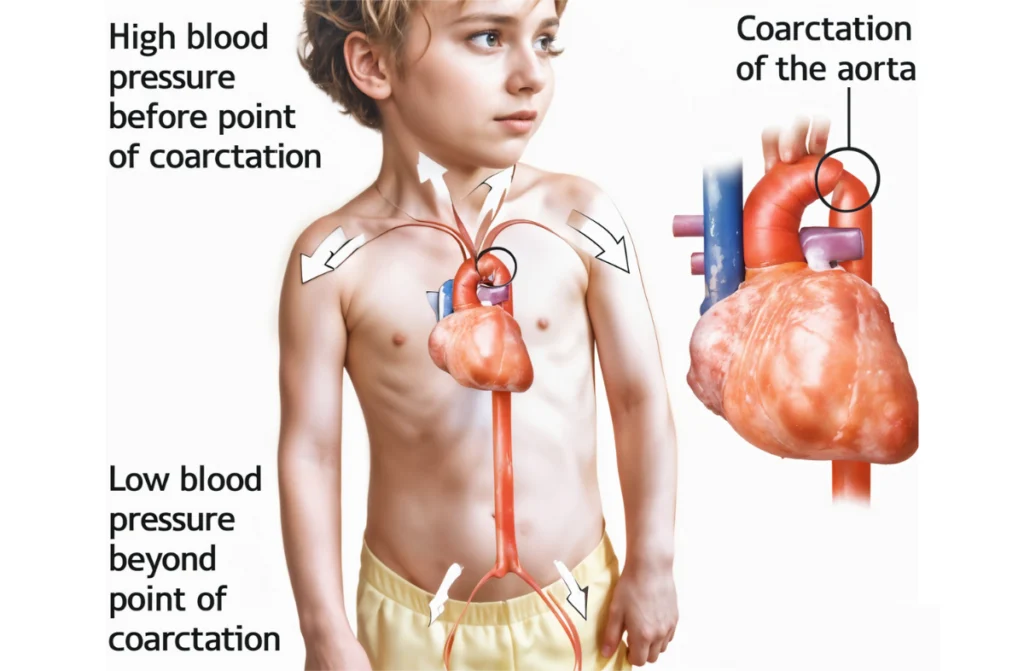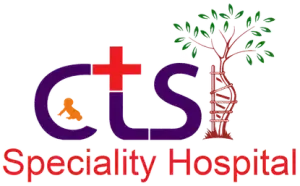Coarctation of the aorta symptoms can be life-threatening if left untreated. Early recognition and specialized care are crucial for managing this serious condition, which affects the main artery that carries oxygen-rich blood from the heart to the rest of the body. CTS Hospital provides expert diagnosis and advanced treatment options that help patients achieve healthier outcomes and improved quality of life. In this guide, we’ll explore the key symptoms, diagnosis methods, treatment options, and long-term care strategies for coarctation of the aorta.
What is Coarctation of the Aorta?
Coarctation of the aorta is a congenital heart defect where the aorta narrows, restricting blood flow and forcing the heart to work harder. Symptoms may not be obvious in mild cases but can worsen over time, leading to serious complications like heart failure or stroke. How to diagnose coarctation of aorta involves imaging tests, such as echocardiograms, MRI, or CT scans, and comparing blood pressure in the arms and legs.

Symptoms of Coarctation of the Aorta in Infants
Recognizing coarctation of the aorta symptoms in newborns is critical because the condition can escalate quickly, leading to life-threatening situations if left untreated.
- Fast Pulse
A rapid pulse, especially in the upper body, signals extra strain on the heart from restricted blood flow. - Gray or Pale Skin
Poor oxygenation causes a pale or grayish complexion due to reduced circulation. - Fatigue and Irritability
Babies tire easily and may appear fussy, even with minimal effort, due to heart stress. - Heavy Sweating
Excessive sweating, particularly during feeding, is a common indicator of this condition. - Trouble Breathing
Labored or rapid breathing points to severe cardiac strain and compromised blood flow. - Trouble with Feeding
Feeding difficulties and poor weight gain are major concerns linked to this defect.
Coarctation of Aorta Newborn Symptoms
For newborns, recognizing the coarctation of aorta newborn symptoms is essential to prevent serious health complications. Early detection helps in providing timely treatment to avoid fatal outcomes.
- Difficulty Breathing: Respiratory distress is a common symptom that may require emergency medical attention. Infants may struggle to breathe, indicating severe circulatory issues.
- Weak Pulses in the Legs: Blood flow to the legs is significantly weaker than in the arms, and pulses in the lower limbs may be barely detectable. This is a critical to watch for in newborns.
- Pale or Cool Skin: Reduced blood supply to the extremities can cause the skin to become cool and pale, especially on the legs and feet. Recognizing these coarctation of the aorta symptoms early is essential for ensuring timely care.
Symptoms of Coarctation of the Aorta in Older Children and Adults
coarctation of aorta newborn symptoms in older children and in some adults differ but are just as serious, with signs like high blood pressure, headaches, and cold feet.
- High Blood Pressure: Elevated blood pressure in the arms is one of the most noticeable signs. This is because the narrowed aorta forces blood to build up before the obstruction, leading to increased pressure in the upper body.
- Cold Feet or Leg Pain: Poor circulation to the lower limbs can result in cold feet or muscle pain during physical activity, such as walking or running.
- Headaches and Dizziness: Insufficient blood flow to the brain can cause headaches, dizziness, and even fainting. These symptoms may become more noticeable as the condition worsens.
How to Diagnose Coarctation of the Aorta
Accurate diagnosis is key for managing coarctation of the aorta. Can coarctation of the aorta be cured? While it can’t be permanently cured, early treatment through surgery or catheter procedures can effectively manage the condition.
- Echocardiogram: The most frequently used diagnostic test for coarctation of the aorta. It uses sound waves to create detailed images of the heart and aorta, helping doctors visualize the narrowing.
- MRI and CT Scans: These imaging techniques provide a clearer, more detailed view of the aorta, allowing doctors to pinpoint the location and severity of the narrowing.
- Blood Pressure Comparison: Doctors often measure blood pressure in both the arms and the legs. A significant difference, with higher blood pressure in the arms and lower pressure in the legs, is a key diagnostic sign of coarctation of the aorta.
Recognizing how to diagnose coarctation of aorta early is crucial, especially for infants and children. Early detection allows for prompt treatment, which greatly improves the prognosis for those affected.
Treatment Options for Coarctation of the Aorta
Treatment for coarctation of the aorta is aimed at restoring normal blood flow, reducing the strain on the heart, and preventing complications. Recognizing the coarctation of the aorta symptoms early is crucial for determining the most appropriate treatment plan
Surgical Repair
- Resection with End-to-End Anastomosis: In this surgery, the narrowed portion of the aorta is removed, and the healthy ends are connected. This procedure is effective but requires careful monitoring to prevent restenosis.
- Extended End-to-End Anastomosis: A more advanced form of the previous procedure, this surgery removes a longer section of the aorta, which reduces the risk of the narrowing returning.
- Subclavian Flap Aortoplasty: In this surgery, a section of the left subclavian artery is used to enlarge the aorta, improving blood flow.
- Patch Aortoplasty: A synthetic or biological patch is used to widen the narrowed section of the aorta, allowing blood to flow more freely.
Cardiac Catheterization
- Balloon Angioplasty: A balloon is inflated inside the narrowed area of the aorta to widen the passage and improve blood flow.
- Balloon Angioplasty with Stent Placement: A stent may be inserted to hold the aorta open after balloon angioplasty, helping to maintain proper blood circulation.
Can Coarctation of the Aorta Be Cured?
While coarctation of the aorta cannot be permanently “cured,” it can be effectively treated. Early surgical repair or catheter-based interventions allow most patients to lead normal, healthy lives. Recognizing the coarctation of the aorta symptoms early on significantly improves the chances of successful treatment
For those wondering, can coarctation of the aorta be cured, the answer is that while treatment is highly effective, ongoing care is necessary for long-term health. Early intervention leads to significantly better outcomes and improves the chances of avoiding complications down the road.
Complications of Aortic Coarctation Repair
Even after successful repair, some complications may arise:
- Restenosis: The aorta may narrow again after treatment, which may require additional procedures to restore normal blood flow.
- Persistent High Blood Pressure: Some patients may continue to experience high blood pressure, which may need to be managed with medications.
- Aneurysm Formation: The aorta wall may weaken in certain areas, increasing the risk of aneurysms. These are coarctation of the aorta symptoms which can be life-threatening if they rupture.
Conclusion
Coarctation of the aorta symptoms should never be ignored. Early diagnosis and specialized care can significantly improve outcomes and prevent severe complications. At CTS Hospital, we provide comprehensive evaluations, expert treatment options, and long-term follow-up care to ensure the best possible results for our patients. Contact us today to learn more or schedule an appointment. Early intervention can prevent severe complications and offer a healthier, brighter future for those affected.
